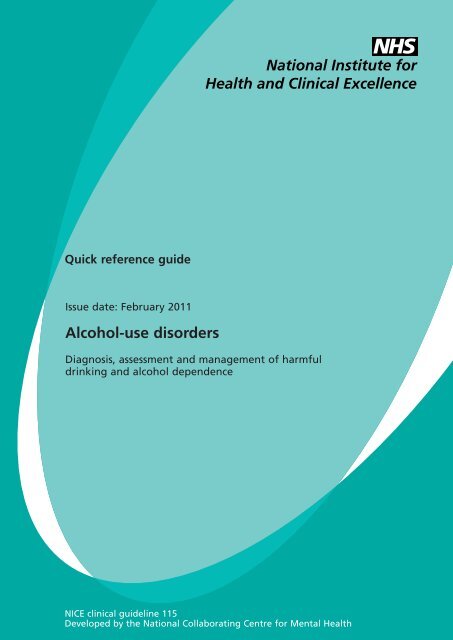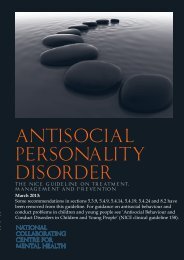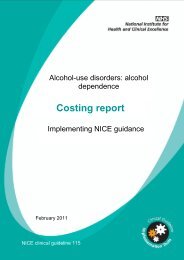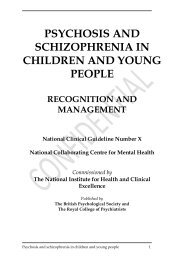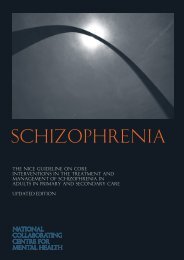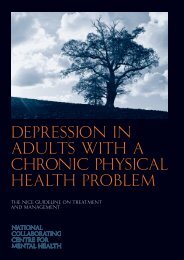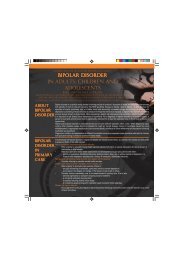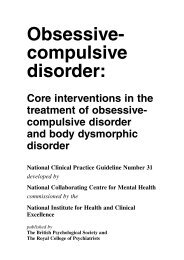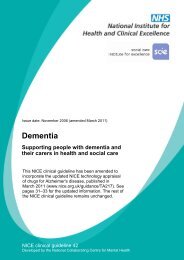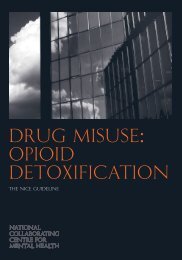Alcohol-use disorders - National Institute for Health and Clinical ...
Alcohol-use disorders - National Institute for Health and Clinical ...
Alcohol-use disorders - National Institute for Health and Clinical ...
You also want an ePaper? Increase the reach of your titles
YUMPU automatically turns print PDFs into web optimized ePapers that Google loves.
Quick reference guideIssue date: February 2011<strong>Alcohol</strong>-<strong>use</strong> <strong>disorders</strong>Diagnosis, assessment <strong>and</strong> management of harmfuldrinking <strong>and</strong> alcohol dependenceNICE clinical guideline 115Developed by the <strong>National</strong> Collaborating Centre <strong>for</strong> Mental <strong>Health</strong>
<strong>Alcohol</strong>-<strong>use</strong> <strong>disorders</strong>: diagnosis, assessment <strong>and</strong>management of harmful drinking <strong>and</strong> alcohol dependenceAbout this bookletThis is aquick reference guide that summarises the recommendations NICE has made to the NHS in‘<strong>Alcohol</strong>-<strong>use</strong> <strong>disorders</strong>: diagnosis, assessment <strong>and</strong> management of harmful drinking <strong>and</strong> alcoholdependence‘ (NICE clinical guideline 115).Who should read this booklet?This quick reference guide is <strong>for</strong> GPs; social workers; staff inspecialist alcohol services (includingNHS <strong>and</strong> those funded by the NHS), acute hospitals <strong>and</strong> accident <strong>and</strong> emergency departments;staff inprison health services; <strong>and</strong> other staff who care <strong>for</strong> people who mis<strong>use</strong> alcohol.Who wrote the guideline?The guideline was developed by the <strong>National</strong> Collaborating Centre <strong>for</strong> Mental <strong>Health</strong>, which isbased at the Royal College of Psychiatrists <strong>and</strong> the British Psychological Society. The CollaboratingCentre worked with agroup of healthcare professionals (including consultants, GPs <strong>and</strong> nurses),people who mis<strong>use</strong> alcohol <strong>and</strong> carers, <strong>and</strong> technical staff, who reviewed the evidence <strong>and</strong> draftedthe recommendations. The recommendations were finalised after public consultation.For more in<strong>for</strong>mation on how NICE clinical guidelines are developed, go to www.nice.org.ukWhere can Iget more in<strong>for</strong>mation about the guideline?The NICE website has the recommendations in full, reviews of the evidence they are based on,asummary of the guideline <strong>for</strong> service <strong>use</strong>rs <strong>and</strong> carers, <strong>and</strong> tools to support implementation (seeback cover <strong>for</strong> more details).<strong>National</strong> <strong>Institute</strong> <strong>for</strong><strong>Health</strong> <strong>and</strong> <strong>Clinical</strong> ExcellenceMidCity Place71 High HolbornLondonWC1V 6NAwww.nice.org.ukISBN 978-1-84936-491-1©<strong>National</strong> <strong>Institute</strong> <strong>for</strong> <strong>Health</strong> <strong>and</strong> <strong>Clinical</strong>Excellence, 2011. All rights reserved. This materialmay be freely reproduced <strong>for</strong> educational <strong>and</strong>not-<strong>for</strong>-profit purposes. No reproduction by or<strong>for</strong> commercial organisations, or <strong>for</strong> commercialpurposes, is allowed without the express writtenpermission of NICE.NICE clinical guidelines are recommendations about the treatment <strong>and</strong> care ofpeople with specificdiseases <strong>and</strong> conditions inthe NHS in Engl<strong>and</strong> <strong>and</strong> Wales.This guidance represents the view of NICE, which was arrived at after careful consideration ofthe evidence available. <strong>Health</strong>care professionals are expected to take it fully into account whenexercising their clinical judgement. However, the guidance does not override the individualresponsibility of healthcare professionals to make decisions appropriate to the circumstances ofthe individual patient, in consultation with the patient <strong>and</strong>/or guardian or carer, <strong>and</strong> in<strong>for</strong>medby the summary of product characteristics ofany drugs they are considering.Implementation ofthis guidance is the responsibility of local commissioners <strong>and</strong>/or providers.Commissioners <strong>and</strong> providers are reminded that it is their responsibility to implement the guidance,in their local context, in light of their duties to avoid unlawful discrimination <strong>and</strong> to have regard topromoting equality of opportunity. Nothing in this guidance should be interpreted in away thatwould be inconsistent with compliance with those duties.
<strong>Alcohol</strong>-<strong>use</strong> <strong>disorders</strong>: diagnosis, assessment <strong>and</strong>management ofharmful drinking <strong>and</strong> alcohol dependenceContentsContentsIntroduction 4Key to terms 4Key priorities <strong>for</strong> implementation 5Working with people who mis<strong>use</strong> alcohol 7Identification <strong>and</strong> assessment 8Interventions <strong>for</strong> alcohol mis<strong>use</strong> 12Working with families <strong>and</strong> carers 23Further in<strong>for</strong>mation 24This is one of three pieces of NICE guidance addressing alcohol-related problems <strong>and</strong> should beread along with:●●‘<strong>Alcohol</strong>-<strong>use</strong> <strong>disorders</strong>: preventing the development of hazardous <strong>and</strong> harmful drinking’NICE public health guidance 24 (2010). Available from www.nice.org.uk/guidance/PH24.Public health guidance on the price, advertising <strong>and</strong> availability of alcohol, how best to detectalcohol mis<strong>use</strong> in <strong>and</strong> outside primary care, <strong>and</strong> brief interventions to manage it in thesesettings.‘<strong>Alcohol</strong>-<strong>use</strong> <strong>disorders</strong>: diagnosis <strong>and</strong> clinical management of alcohol-related physicalcomplications’ NICE clinical guideline 100 (2010). Available fromwww.nice.org.uk/guidance/CG100. Aclinical guideline covering acute unplanned alcoholwithdrawal including delirium tremens, alcohol-related liver damage, alcohol-related pancreatitis<strong>and</strong> management of Wernicke’s encephalopathy.Person-centred careTreatment <strong>and</strong> care should take into account people’s individual needs <strong>and</strong> preferences. Goodcommunication is essential, supported by evidence-based in<strong>for</strong>mation, to allow people to reachin<strong>for</strong>med decisions about their care. Follow advice on seeking consent from the Department of<strong>Health</strong> or Welsh Assembly Government if needed. If the person agrees, families <strong>and</strong> carers shouldhave the opportunity to be involved in decisions about treatment <strong>and</strong> care. If caring <strong>for</strong> youngpeople in transition between paediatric <strong>and</strong> adult services refer to ‘Transition: getting it right <strong>for</strong>young people’ (available from www.dh.gov.uk).NICE clinical guideline 115Quick reference guide3
<strong>Alcohol</strong>-<strong>use</strong> <strong>disorders</strong>: diagnosis, assessment <strong>and</strong>management of harmful drinking <strong>and</strong> alcohol dependenceIntroductionIntroductionHarmful drinking <strong>and</strong> alcohol dependence ca<strong>use</strong> many mental <strong>and</strong> physical health problems, <strong>and</strong>social problems. In Engl<strong>and</strong>, 4% of people aged between 16 <strong>and</strong> 65 are dependent on alcohol(6% of men <strong>and</strong> 2% of women). More than 24% of the English population (33% of men <strong>and</strong>16% of women) consume alcohol in away that is potentially oractually harmful totheir healthor wellbeing. <strong>Alcohol</strong> mis<strong>use</strong> is also an increasing problem in children <strong>and</strong> young people. Currentpractice across the country is varied, which leads to variation in access to arange of assistedwithdrawal <strong>and</strong> treatment services.This guideline makes recommendations on the diagnosis, assessment <strong>and</strong> management of harmfuldrinking <strong>and</strong> alcohol dependence in adults <strong>and</strong> in young people aged 10–17 years.At the time of publication, no drug recommended in this guideline has aUKmarketing authorisation<strong>for</strong> <strong>use</strong> in children <strong>and</strong> young people under the age of 18. However, in2000, the Royal College ofPaediatrics <strong>and</strong> Child <strong>Health</strong> issued apolicy statement on the <strong>use</strong> of unlicensed medicines, or the <strong>use</strong>of licensed medicines <strong>for</strong> unlicensed applications, in children <strong>and</strong> young people. This states that such<strong>use</strong> is necessary in paediatric practice <strong>and</strong> that doctors are legally allowed to prescribe unlicensedmedicines where there are no suitable alternatives <strong>and</strong> where the <strong>use</strong> is justified by aresponsiblebody of professional opinion.Key to terms<strong>Alcohol</strong> dependence: characterised by craving, tolerance, apreoccupation with alcohol <strong>and</strong>continued drinking in spite of harmful consequences.<strong>Alcohol</strong> mis<strong>use</strong>: <strong>use</strong>d in this guideline to refer to harmful drinking <strong>and</strong> alcohol dependence.Mild alcohol dependence: ascore of15orless on the Severity of <strong>Alcohol</strong> DependenceQuestionnaire (SADQ).Moderate alcohol dependence :ascore of15–30 on the SADQ.Severe alcohol dependence: ascore of31ormore onthe SADQ.Harmful drinking: apattern ofalcohol consumption causing health problems directly relatedto alcohol (including psychological problems such as depression, alcohol-related accidents or physicalillness such as acute pancreatitis).Hazardous drinking :apattern ofalcohol consumption that increases someone’s risk of harm.This is covered in NICE public health guidance 24.4NICE clinical guideline 115Quick reference guide
<strong>Alcohol</strong>-<strong>use</strong> <strong>disorders</strong>: diagnosis, assessment <strong>and</strong>management of harmful drinking <strong>and</strong> alcohol dependenceKey priorities <strong>for</strong> implementationKey priorities <strong>for</strong> implementation continued– routinely <strong>use</strong> outcome measurements to make sure that the person who mis<strong>use</strong>s alcohol isinvolved in reviewing the effectiveness of treatment– engage in monitoring <strong>and</strong> evaluation of treatment adherence <strong>and</strong> practice competence,<strong>for</strong> example, by using video <strong>and</strong> audio tapes <strong>and</strong> external audit <strong>and</strong> scrutiny if appropriate.Interventions <strong>for</strong> harmful drinking <strong>and</strong> mild alcohol dependence● For harmful drinkers <strong>and</strong> people with mild alcohol dependence, offer apsychologicalintervention (such as cognitive behavioural therapies, behavioural therapies or social network<strong>and</strong> environment-based therapies) foc<strong>use</strong>d specifically on alcohol-related cognitions, behaviour,problems <strong>and</strong> social networks.Assessment <strong>for</strong> assisted alcohol withdrawal● For service <strong>use</strong>rs who typically drink over 15 units of alcohol per day, <strong>and</strong>/or who score 20ormore onthe AUDIT, consider offering:– anassessment <strong>for</strong> <strong>and</strong> delivery of acommunity-based assisted withdrawal, or– assessment <strong>and</strong> management in specialist alcohol services if there are safety concerns(see page 15) about acommunity-based assisted withdrawal.Interventions <strong>for</strong> moderate <strong>and</strong> severe alcohol dependence● After asuccessful withdrawal <strong>for</strong> people with moderate <strong>and</strong> severe alcohol dependence,consider offering acamprosate or oral naltrexone 2 in combination with an individual psychologicalintervention (cognitive behavioural therapies, behavioural therapies or social network <strong>and</strong>environment-based therapies) foc<strong>use</strong>d specifically on alcohol mis<strong>use</strong> (see page 13).Assessment <strong>and</strong> interventions <strong>for</strong> children <strong>and</strong> young people who mis<strong>use</strong> alcohol● For children <strong>and</strong> young people aged 10–17 years who mis<strong>use</strong> alcohol offer:– individual cognitive behavioural therapy <strong>for</strong> those with limited comorbidities <strong>and</strong> goodsocial support– multicomponent programmes (such as multidimensional family therapy, brief strategic familytherapy, functional family therapy ormultisystemic therapy) <strong>for</strong> those with significantcomorbidities <strong>and</strong>/or limited social support.Interventions <strong>for</strong> conditions comorbid with alcohol mis<strong>use</strong>● For people who mis<strong>use</strong> alcohol <strong>and</strong> have comorbid depression or anxiety <strong>disorders</strong>, treat thealcohol mis<strong>use</strong> first as this may lead to significant improvement in the depression <strong>and</strong> anxiety.If depression or anxiety continues after 3to4weeks of abstinence from alcohol, undertake anassessment of the depression or anxiety <strong>and</strong> consider referral <strong>and</strong> treatment in line with therelevant NICE guideline <strong>for</strong> the particular disorder 3 .2 At the time of publication (February 2011), oral naltrexone did not have UK marketing authorisation <strong>for</strong> this indication. In<strong>for</strong>medconsent should be obtained <strong>and</strong> documented.3 See ‘Depression in adults’ NICE clinical guideline 90 (2009), available from www.nice.org.uk/guidance/CG90 <strong>and</strong>‘Anxiety’, NICE clinical guideline 113 (2011), available from www.nice.org.uk/guidance/CG1136NICE clinical guideline 115Quick reference guide
<strong>Alcohol</strong>-<strong>use</strong> <strong>disorders</strong>: diagnosis, assessment <strong>and</strong>management ofharmful drinking <strong>and</strong> alcohol dependenceWorking with people whomis<strong>use</strong> alcoholWorking with people who mis<strong>use</strong> alcohol●●●●●●●Build atrusting relationship <strong>and</strong> work in asupportive, empathic <strong>and</strong> non-judgmental manner.Take into account that stigma <strong>and</strong> discrimination are often associated with alcohol mis<strong>use</strong> <strong>and</strong> thatthose presenting to services may minimise their alcohol problem.Hold discussions in settings in which confidentiality, privacy <strong>and</strong> dignity are respected.Provide in<strong>for</strong>mation appropriate to the person’s level of underst<strong>and</strong>ing about the nature <strong>and</strong>treatment of alcohol mis<strong>use</strong> to support choice from arange of evidence-based treatments.Make sure that comprehensive written in<strong>for</strong>mation is available in an appropriate language or in anaccessible <strong>for</strong>mat.Avoid clinical language without explanation.Provide independent interpreters if needed.NICE clinical guideline 115Quick reference guide7
<strong>Alcohol</strong>-<strong>use</strong> <strong>disorders</strong>: diagnosis, assessment <strong>and</strong>management of harmful drinking <strong>and</strong> alcohol dependenceIdentification <strong>and</strong> assessmentIdentification <strong>and</strong> assessmentGeneral principles●Staff working in services provided <strong>and</strong> funded by the NHS who care <strong>for</strong> people who potentiallymis<strong>use</strong> alcohol should be competent to identify harmful drinking <strong>and</strong> alcohol dependence.They should be competent to initially assess the need <strong>for</strong> an intervention or, ifthey are notcompetent, they should refer people who mis<strong>use</strong> alcohol to aservice that can assess need.●●Staff responsible <strong>for</strong> assessing <strong>and</strong> managing assisted alcohol withdrawal should be competent indiagnosing <strong>and</strong> assessing alcohol dependence <strong>and</strong> withdrawal symptoms.Make sure all assessments include risk assessment (including risk to self <strong>and</strong> to others). This shouldin<strong>for</strong>m the care plan.Assessment tools●Use <strong>for</strong>mal assessment tools to assess the nature <strong>and</strong> severity of alcohol mis<strong>use</strong>, including the:– AUDIT <strong>for</strong> identification <strong>and</strong> as aroutine outcome measure– SADQ or LDQ <strong>for</strong> severity of dependence– <strong>Clinical</strong> <strong>Institute</strong> Withdrawal Assessment of <strong>Alcohol</strong> Scale, revised (CIWA-Ar) <strong>for</strong> severity of withdrawal– APQ <strong>for</strong> the nature <strong>and</strong> extent of the problems arising from alcohol mis<strong>use</strong>.●When assessing the severity of alcohol dependence <strong>and</strong> determining the need <strong>for</strong> assistedwithdrawal, adjust the criteria <strong>for</strong> women, older people, children <strong>and</strong> young people, <strong>and</strong> people withestablished liver disease who may have problems with the metabolism ofalcohol.Initial assessments● When conducting an initial assessment, as well as assessing alcohol mis<strong>use</strong>, the severity ofdependence <strong>and</strong> risk, consider the:– extent of any associated health <strong>and</strong> social problems– need <strong>for</strong> assisted alcohol withdrawal.●Carry out amotivational intervention as part of the initial assessment. Use the key elements ofmotivational interviewing including:– helping people to recognise problems or potential problems related to their drinking– helping to resolve ambivalence <strong>and</strong> encourage positive change <strong>and</strong> belief in the ability to change– being persuasive <strong>and</strong> supportive rather than argumentative <strong>and</strong> confrontational.8NICE clinical guideline 115Quick reference guide
<strong>Alcohol</strong>-<strong>use</strong> <strong>disorders</strong>: diagnosis, assessment <strong>and</strong>management ofharmful drinking <strong>and</strong> alcohol dependenceIdentification <strong>and</strong> assessmentAssessment <strong>and</strong> referral of children <strong>and</strong> young people aged 10–17 years● If alcohol mis<strong>use</strong> is identified as apotential problem, with potential physical, psychological,educational, or social consequences, assess:– the duration <strong>and</strong> severity of the alcohol mis<strong>use</strong> (the st<strong>and</strong>ard adult threshold on the AUDIT<strong>for</strong> referral <strong>and</strong> intervention should be lower <strong>for</strong> young people aged 10–16)– any associated health <strong>and</strong> social problems– the potential need <strong>for</strong> assisted withdrawal.●●Refer all children <strong>and</strong> young people aged 10–15 years to aspecialist child <strong>and</strong> adolescentmental health service (CAMHS) <strong>for</strong> acomprehensive assessment of their needs (see page 11),if their alcohol mis<strong>use</strong> is associated with physical, psychological, educational <strong>and</strong> social problems<strong>and</strong>/or comorbid drug mis<strong>use</strong>.When considering referral to CAMHS <strong>for</strong> young people aged 16–17 who mis<strong>use</strong> alcohol, <strong>use</strong>the same referral criteria as<strong>for</strong> adults (see ‘Assessment in specialist alcohol services’ below).Assessment in specialist alcohol servicesBrief triage assessment –all adults●Conduct abrief triage assessment to assess:– the pattern <strong>and</strong> severity ofthe alcohol mis<strong>use</strong> (using AUDIT) <strong>and</strong> severity of dependence (using SADQ)– the need <strong>for</strong> urgent treatment including assisted withdrawal– any associated risks to self or others– comorbidities or other factors that may need further specialist assessment or intervention.●Agree the initial treatment plan, taking into account the service <strong>use</strong>r’s preferences <strong>and</strong> outcomes ofany previous treatment.Treatment goals●Agree the goal of treatment with the service <strong>use</strong>r at the initial assessment:– Abstinence is the appropriate goal <strong>for</strong> most people with alcohol dependence, <strong>and</strong> people whomis<strong>use</strong> alcohol <strong>and</strong> have significant psychiatric or physical comorbidity.– Ifaservice <strong>use</strong>r prefers agoal of moderation but there are considerable risks, advise strongly thatabstinence is most appropriate but do not ref<strong>use</strong> treatment if they do not agree to abstinence.– For harmful drinking <strong>and</strong> mild dependence without significant comorbidities, if there isadequatesocial support, consider moderate drinking unless the person prefers abstinence or there are otherreasons <strong>for</strong> advising abstinence.– Ifaperson has severe alcohol dependence, or mis<strong>use</strong>s alcohol <strong>and</strong> has asignificant psychiatric orphysical comorbidity, but is unwilling to consider agoal of abstinence or engage in structuredtreatment, consider harm reduction. However, ultimately the service <strong>use</strong>r should be encouraged toaim <strong>for</strong> agoal of abstinence.●When developing treatment goals, consider that some people who mis<strong>use</strong> alcohol may be required toabstain from alcohol as part of acourt order or sentence.NICE clinical guideline 115Quick reference guide9
<strong>Alcohol</strong>-<strong>use</strong> <strong>disorders</strong>: diagnosis, assessment <strong>and</strong>management of harmful drinking <strong>and</strong> alcohol dependenceIdentification <strong>and</strong> assessmentChildren <strong>and</strong> young people aged 10–17 years who mis<strong>use</strong> alcohol●The goal of treatment should usually be abstinence in the first instance.Comprehensive assessment <strong>for</strong> adults●Consider acomprehensive assessment structured as aclinical interview <strong>for</strong> adults scoring morethan 15 on the AUDIT. This should assess multiple areas of need <strong>and</strong> <strong>use</strong> relevant <strong>and</strong> validatedclinical tools (see page 8). It should cover the following:– alcohol <strong>use</strong>, including consumption (historical <strong>and</strong> recent patterns ofdrinking, <strong>and</strong> ifpossible, additional in<strong>for</strong>mation, <strong>for</strong> example, from afamily member or carer), dependence(using, <strong>for</strong> example, SADQ or LDQ) <strong>and</strong> alcohol-related problems (using, <strong>for</strong> example, APQ)– other drug mis<strong>use</strong>, including over-the-counter medication– physical health problems– psychological <strong>and</strong> social problems– cognitive function (<strong>for</strong> example, MMSE)– readiness <strong>and</strong> belief in ability to change.●●●●●Assess comorbid mental health problems as part of any comprehensive assessment, <strong>and</strong> throughoutcare <strong>for</strong> the alcohol mis<strong>use</strong>. Use this to in<strong>for</strong>m the care plan (see section on comorbid conditionson page 22).If comorbid mental health problems do not significantly improve after abstinence from alcohol(typically after 3–4 weeks), consider providing or referring <strong>for</strong> specific treatment (see the relevantNICE guideline).Consider brief measures of cognitive functioning (<strong>for</strong> example, MMSE) to help with treatmentplanning. Formal measures of cognitive functioning should usually only be per<strong>for</strong>med if impairmentpersists after aperiod of abstinence or asignificant reduction in alcohol intake.Consider measuring breath alcohol as part of the management of assisted withdrawal. However,breath alcohol should not usually be measured <strong>for</strong> routine assessment <strong>and</strong> monitoring in alcoholtreatment programmes.Consider blood tests to help identify physical health needs, but do not <strong>use</strong> them routinely <strong>for</strong>identifying <strong>and</strong> diagnosing alcohol <strong>use</strong> <strong>disorders</strong>.10NICE clinical guideline 115Quick reference guide
<strong>Alcohol</strong>-<strong>use</strong> <strong>disorders</strong>: diagnosis, assessment <strong>and</strong>management ofharmful drinking <strong>and</strong> alcohol dependenceIdentification <strong>and</strong> assessmentComprehensive assessment <strong>for</strong> children <strong>and</strong> young people aged 10–17 years●Assess multiple areas of need, with aclinical interview using avalidated clinical tool (such asthe Adolescent Diagnostic Interview [ADI] or the Teen Addiction Severity Index [T-ASI]).Support the assessment with additional in<strong>for</strong>mation from aparent or carer if possible.Cover the following:– consumption, dependence features <strong>and</strong> patterns of drinking– comorbid substance mis<strong>use</strong> (consumption <strong>and</strong> dependence features) <strong>and</strong> associated problems– mental <strong>and</strong> physical health problems– peer relationships <strong>and</strong> social <strong>and</strong> family functioning– developmental <strong>and</strong> cognitive needs, <strong>and</strong> educational attainment <strong>and</strong> attendance– history of ab<strong>use</strong> <strong>and</strong> trauma– risk to self <strong>and</strong> others– readiness to change <strong>and</strong> belief in the ability to change– obtaining consent to treatment– <strong>for</strong>mulation of acare plan <strong>and</strong> risk management plan.NICE clinical guideline 115Quick reference guide11
<strong>Alcohol</strong>-<strong>use</strong> <strong>disorders</strong>: diagnosis, assessment <strong>and</strong>management of harmful drinking <strong>and</strong> alcohol dependenceInterventions <strong>for</strong> alcohol mis<strong>use</strong>Interventions <strong>for</strong> alcohol mis<strong>use</strong>General principles●All interventions <strong>for</strong> people who mis<strong>use</strong> alcohol should be:– delivered by appropriately trained <strong>and</strong> competent staff– the subject of routine outcome monitoring. This should be <strong>use</strong>d to in<strong>for</strong>m decisions aboutcontinuing psychological <strong>and</strong> pharmacological treatments.● Pharmacological interventions should be administered by specialist <strong>and</strong> competent staff 4 .●●Psychological interventions should be based on arelevant evidence-based treatment manual, whichshould guide the structure <strong>and</strong> duration of the intervention. Staff should consider using competenceframeworks developed from the relevant treatment manuals <strong>and</strong> <strong>for</strong> all interventions should:– receive regular supervision from individuals competent in both the intervention <strong>and</strong> supervision– routinely <strong>use</strong> outcome measurements to make sure that the person who mis<strong>use</strong>s alcohol isinvolved in reviewing the effectiveness of treatment– engage in monitoring <strong>and</strong> evaluation of treatment adherence <strong>and</strong> practice competence, <strong>for</strong>example, by using video <strong>and</strong> audio tapes <strong>and</strong> external audit <strong>and</strong> scrutiny if appropriate.For all people who mis<strong>use</strong> alcohol, offer interventions to promote abstinence or moderate drinkingas appropriate (see ‘Treatment goals’ on page 9) <strong>and</strong> prevent relapse, in community-based settings.●Consider offering interventions to promote abstinence <strong>and</strong> prevent relapse as part of anintensive structured community-based intervention <strong>for</strong> people with moderate <strong>and</strong> severe alcoholdependence who have:– very limited social support (<strong>for</strong> example, living alone or having little contact with family orfriends) or– complex physical or psychiatric comorbidities or– not responded to initial community-based interventions.●●●For all people seeking help <strong>for</strong> alcohol mis<strong>use</strong>:– give in<strong>for</strong>mation on the value <strong>and</strong> availability of community support networks <strong>and</strong> self-help groups(<strong>for</strong> example, <strong>Alcohol</strong>ics Anonymous or SMART recovery) <strong>and</strong>– help them to participate in community support networks <strong>and</strong> self-help groups by encouragingthem to go to meetings <strong>and</strong> arranging support so that they can attend.For people with alcohol dependence who are homeless, consider offering residential rehabilitation<strong>for</strong> amaximum of 3months. Help the service <strong>use</strong>r find stable accommodation be<strong>for</strong>e discharge.Consider stopping the treatment <strong>and</strong> review the care plan if there are signs of deterioration or noindications ofimprovement.4 If adrug is <strong>use</strong>d at adose or <strong>for</strong> an application that does not have UK marketing authorisation, in<strong>for</strong>med consent should beobtained <strong>and</strong> documented.12NICE clinical guideline 115Quick reference guide
<strong>Alcohol</strong>-<strong>use</strong> <strong>disorders</strong>: diagnosis, assessment <strong>and</strong>management ofharmful drinking <strong>and</strong> alcohol dependenceInterventions <strong>for</strong> alcohol mis<strong>use</strong>Care coordination <strong>and</strong> case management● Care coordination should be part of the routine care ofall service <strong>use</strong>rs in specialist alcohol services<strong>and</strong> should:– beprovided throughout the whole period of care, including aftercare– bedelivered by appropriately trained <strong>and</strong> competent staff working in specialist alcohol services– include the coordination of assessment, interventions <strong>and</strong> monitoring of progress, <strong>and</strong>coordination with other agencies.●●●Consider case management to increase engagement in treatment <strong>for</strong> people who have moderate tosevere alcohol dependence <strong>and</strong> who are considered at risk of dropping out of treatment or who haveaprevious history of poor engagement. If case management is provided, it should be throughout thewhole period of care, including aftercare.Case management should be delivered in the context of Tier 3interventions by staff responsible <strong>for</strong>the overall coordination of care.Case management should include:– a comprehensive assessment of needs– developing an individualised care plan with the service <strong>use</strong>r <strong>and</strong> relevant others– coordinating the care plan to deliver aseamless multiagency <strong>and</strong> integrated care pathway <strong>and</strong>maximisation ofengagement, including using motivational interviewing– monitoring the impact of interventions <strong>and</strong> revising the care plan when necessary.Interventions <strong>for</strong> harmful drinking <strong>and</strong> mild alcohol dependence●Offer apsychological intervention (such as cognitive behavioural therapies, behaviouraltherapies or social network <strong>and</strong> environment-based therapies) foc<strong>use</strong>d specifically onalcohol-related cognitions, behaviour, problems <strong>and</strong> social networks (see table on page 14).●●Offer behavioural couples therapy to service <strong>use</strong>rs who have aregular partner who is willing toparticipate in treatment.If service <strong>use</strong>rs have not responded to psychological interventions alone, or specifically request apharmacological intervention, consider offering acamprosate 5 or oral naltrexone 6 in combination withan individual psychological intervention (such as cognitive behavioural therapies, behavioural therapiesor social network <strong>and</strong> environment-based therapies) or behavioural couples therapy. (See page 18 <strong>for</strong>pharmacological interventions <strong>and</strong> page 14 <strong>for</strong> psychological interventions.)5 Note that the evidence <strong>for</strong> acamprosate in the treatment of harmful drinkers <strong>and</strong> people who are mildly alcohol dependent isless robust than that <strong>for</strong> naltrexone. At the time of publication (February 2011), acamprosate did not have UK marketingauthorisation <strong>for</strong> this indication. In<strong>for</strong>med consent should be obtained <strong>and</strong> documented.6 At the time of publication (February 2011), oral naltrexone did not have UK marketing authorisation <strong>for</strong> this indication.In<strong>for</strong>med consent should be obtained <strong>and</strong> documented.NICE clinical guideline 115Quick reference guide13
<strong>Alcohol</strong>-<strong>use</strong> <strong>disorders</strong>: diagnosis, assessment <strong>and</strong>management of harmful drinking <strong>and</strong> alcohol dependenceInterventions <strong>for</strong> alcohol mis<strong>use</strong>Delivering psychological <strong>and</strong> psychosocial interventionsIntervention Focus Length <strong>and</strong> frequencyCognitive behavioural <strong>Alcohol</strong>-related problems Usually one 60-minute session per weektherapies<strong>for</strong> 12 weeksBehavioural therapies <strong>Alcohol</strong>-related problems Usually one 60-minute session per week<strong>for</strong> 12 weeksSocial network <strong>and</strong> <strong>Alcohol</strong>-related problems Usually eight 50-minute sessions overenvironment-based12 weekstherapiesBehavioural couples <strong>Alcohol</strong>-related problems <strong>and</strong> their Usually one 60-minute session per weektherapy impact on relationships. <strong>for</strong> 12 weeksAim: abstinence, or alevel ofdrinking predetermined <strong>and</strong> agreedby the therapist <strong>and</strong> the service <strong>use</strong>rto be reasonable <strong>and</strong> safe.14NICE clinical guideline 115Quick reference guide
<strong>Alcohol</strong>-<strong>use</strong> <strong>disorders</strong>: diagnosis, assessment <strong>and</strong>management ofharmful drinking <strong>and</strong> alcohol dependenceInterventions <strong>for</strong> alcohol mis<strong>use</strong>Assisted alcohol withdrawalPerson who drinks >15units alcohol per day <strong>and</strong>/orscores ≥ 20 on AUDITAssessment● Consider offering:– assessment <strong>for</strong> <strong>and</strong> delivery of acommunity-basedassisted withdrawal, or– assessment <strong>and</strong> management in specialist alcoholservices if there are safety concerns about acommunity-based assisted withdrawal.Community-basedassisted withdrawal● Service <strong>use</strong>rs whoneed assistedwithdrawal shouldusually be offered acommunity-basedprogramme –vary inintensity according tothe severity of thedependence, availablesocial support <strong>and</strong>comorbidities.● Offer an outpatientbasedprogramme<strong>for</strong> people with mildto moderatedependence inwhich contactbetween staff <strong>and</strong>the service <strong>use</strong>raverages 2–4meetings per weekover the first week.● Outpatient-basedcommunity assistedwithdrawalprogrammes shouldconsist of adrugregimen (see page16) <strong>and</strong> psychosocialsupport includingmotivationalinterviewing.Inpatient <strong>and</strong> residential assisted withdrawal● Consider inpatient or residential assisted withdrawal if aservice <strong>use</strong>rmeets one or more ofthe following criteria. They:– drink over 30 units of alcohol per day– have ascore ofmore than 30 on the SADQ– have ahistory of epilepsy or experience of withdrawal-relatedseizures or delirium tremens during previous assistedwithdrawal programmes– need concurrent withdrawal from alcohol <strong>and</strong> benzodiazepines– regularly drink between 15 <strong>and</strong> 20 units of alcohol per day<strong>and</strong> have:◆ significant psychiatric or physical comorbidities (<strong>for</strong> example,chronic severe depression, psychosis, malnutrition, congestivecardiac failure, unstable angina, chronic liver disease) or◆ asignificant learning disability or cognitive impairment.● Consider alower threshold <strong>for</strong> inpatient or residential assistedwithdrawal in vulnerable groups, <strong>for</strong> example, homeless <strong>and</strong>older people.● See page 20 <strong>for</strong> special considerations <strong>for</strong> children <strong>and</strong> young people.Intensive community programmes after assisted withdrawal <strong>for</strong>severe dependence or mild to moderate dependence withcomplex needs● Offer an intensive community programme inwhich the service <strong>use</strong>rmay attend aday programme lasting between 4<strong>and</strong> 7days perweek over a3-week period.● Intensive community programmes should consist of adrug regimen(see page 16) supported by psychological interventions includingindividual treatments (see page 17), group treatments,psychoeducational interventions, help to attend self-help groups,family <strong>and</strong> carer support <strong>and</strong> involvement, <strong>and</strong> case management(see page 13).NICE clinical guideline 115Quick reference guide15
<strong>Alcohol</strong>-<strong>use</strong> <strong>disorders</strong>: diagnosis, assessment <strong>and</strong>management ofharmful drinking <strong>and</strong> alcohol dependenceInterventions <strong>for</strong> alcohol mis<strong>use</strong>Co-existing benzodiazepine <strong>and</strong> alcohol dependence●●●●●Increase the dose of benzodiazepine <strong>use</strong>d <strong>for</strong> withdrawal.Calculate the initial daily dose based on the requirements <strong>for</strong> alcohol withdrawal plus the equivalentregularly <strong>use</strong>d daily dose of benzodiazepine 10 .This is best managed with one benzodiazepine (chlordiazepoxide or diazepam) rather than multiplebenzodiazepines.Inpatient regimens should last <strong>for</strong> 2–3 weeks or longer, depending on the severity of co-existingbenzodiazepine dependence.Withdrawal managed in the community <strong>and</strong>/or in people with ahigh level of benzodiazepinedependence should last <strong>for</strong> longer than 3weeks, <strong>and</strong> be tailored to the person’s symptoms<strong>and</strong> discom<strong>for</strong>t.●For managing unplanned acute alcohol withdrawal, <strong>and</strong> complications including deliriumtremens <strong>and</strong> withdrawal-related seizures, refer to ‘<strong>Alcohol</strong>-<strong>use</strong> <strong>disorders</strong>: diagnosis <strong>and</strong> clinicalmanagement of alcohol-related physical complications’ (NICE clinical guideline 100).Interventions <strong>for</strong> moderate <strong>and</strong> severe alcohol dependence after successfulwithdrawal●Consider offering acamprosate or oral naltrexone 11 in combination with an individualpsychological intervention (cognitive behavioural therapies, behavioural therapies or socialnetwork <strong>and</strong> environment-based therapies) foc<strong>use</strong>d specifically on alcohol mis<strong>use</strong> (see page 18).●●●Consider offering acamprosate or oral naltrexone 11 in combination with behavioural couples therapyto service <strong>use</strong>rs who have aregular partner who is willing to participate in treatment (see page 14).Consider offering disulfiram 12 in combination with apsychological intervention to service <strong>use</strong>rs who:– want to achieve abstinence but <strong>for</strong> whom acamprosate <strong>and</strong> oral naltrexone are not suitable, or– prefer disulfiram <strong>and</strong> underst<strong>and</strong> the relative risks of taking the drug (see page 19).Be<strong>for</strong>e starting treatment with acamprosate, oral naltrexone 11 or disulfiram, conduct acomprehensivemedical assessment (baseline urea <strong>and</strong> electrolytes <strong>and</strong> liver function tests including gamma glutamyltranspeptidase [GGT]). In particular, consider any contraindications or cautions (see the SPC) <strong>and</strong>discuss with the service <strong>use</strong>r.10 At the time of publication (February 2011), benzodiazepines did not have UK marketing authorisation <strong>for</strong> this indication, or<strong>for</strong> <strong>use</strong> in children <strong>and</strong> young people under 18. In<strong>for</strong>med consent should be obtained <strong>and</strong> documented. This should be done inline with normal st<strong>and</strong>ards of care <strong>for</strong> patients who may lack capacity (see www.publicguardian.gov.uk orwww.wales.nhs.uk/consent) orinline with normal st<strong>and</strong>ards in emergency care.11 At the time of publication (February 2011), oral naltrexone did not have UK marketing authorisation <strong>for</strong> this indication.In<strong>for</strong>med consent should be obtained <strong>and</strong> documented.12 All prescribers should consult the SPC <strong>for</strong> afull description of the contraindications <strong>and</strong> the special considerations of the <strong>use</strong>of disulfiram.NICE clinical guideline 115Quick reference guide17
<strong>Alcohol</strong>-<strong>use</strong> <strong>disorders</strong>: diagnosis, assessment <strong>and</strong>management of harmful drinking <strong>and</strong> alcohol dependenceInterventions <strong>for</strong> alcohol mis<strong>use</strong>Drug treatmentsDrug Start Dosage Usual duration Supervision Important in<strong>for</strong>mationtreatment of treatmentAcamprosate As soon as Usually 1998 mg Up to 6months, or At least monthly, <strong>for</strong> Stop treatment if drinkingpossible after (666 mg three longer <strong>for</strong> those 6months, <strong>and</strong> at persists 4–6 weeks afterassisted times aday) benefiting from the reduced but regular starting the drug.withdrawal. unless the service drug who want to intervals if continued<strong>use</strong>r weighs less continue with it 13 . after this. Do not <strong>use</strong>than 60 kg, <strong>and</strong> blood tests routinely,then amaximum but consider them toof 1332 mg monitor <strong>for</strong> recovery ofper day. liver function <strong>and</strong> as amotivational aid <strong>for</strong>service <strong>use</strong>rs to showimprovement.Oral After assisted Initially 25 mg Up to 6months, or At least monthly, <strong>for</strong> Draw the service <strong>use</strong>r’s attention tonaltrexone 14 withdrawal. per day, aiming longer <strong>for</strong> those 6months, <strong>and</strong> at the in<strong>for</strong>mation card that is issued<strong>for</strong> amaintenance benefiting from the reduced but regular with oral naltrexone about itsdosage of 50 mg drug who want to intervals if continued impact on opioid-based analgesics.per day 14 . continue with it. after this. Do not <strong>use</strong>blood tests routinely, Stop treatment if drinking persistsbut consider them <strong>for</strong> 4–6 weeks after starting the drug.older people, <strong>for</strong>people with obesity, Ifthe service <strong>use</strong>r feels unwell advise<strong>for</strong> monitoring them to stop the oral naltrexonerecovery of liver immediately.function <strong>and</strong> as amotivational aid <strong>for</strong>service <strong>use</strong>rs to showimprovement.13 At the time of publication (February 2011), acamprosate did not have UK marketing authorisation <strong>for</strong> <strong>use</strong> longer than 12 months. In<strong>for</strong>medconsent should be obtained <strong>and</strong> documented.14 At the time of publication (February 2011), oral naltrexone did not have UK marketing authorisation <strong>for</strong> this indication or at this dosage.In<strong>for</strong>med consent should be obtained <strong>and</strong> documented.continued18NICE clinical guideline 115Quick reference guide
<strong>Alcohol</strong>-<strong>use</strong> <strong>disorders</strong>: diagnosis, assessment <strong>and</strong>management of harmful drinking <strong>and</strong> alcohol dependenceInterventions <strong>for</strong> alcohol mis<strong>use</strong>Drug treatments continuedDrug Start Dosage Supervision Important in<strong>for</strong>mationtreatmentDisulfiram At least Usually 200 mg per day. Atleast every 2weeks Be<strong>for</strong>e starting treatment with24 hours <strong>for</strong> the first 2months, disulfiram, test liver function,after the last For people who continue to drink, then monthly <strong>for</strong> the urea <strong>and</strong> electrolytes to assessalcoholic drink if 200 mg taken regularly <strong>for</strong> at following 4months. <strong>for</strong> liver or renal impairment.consumed. least 1week does not ca<strong>use</strong> asufficiently unpleasant reaction to Service <strong>use</strong>rs should Check the SPC <strong>for</strong> warnings <strong>and</strong>deter drinking, consider increasing the be medically monitored contraindications in pregnancy <strong>and</strong> indosage in consultation with the person. at least every 6months the following conditions: ahistory ofafter the initial severe mental illness, stroke, heart6months of treatment disease or hypertension.<strong>and</strong> monitoring.If possible, afamily member or carer,who is properly in<strong>for</strong>med about the<strong>use</strong> of disulfiram, should overseeadministration of the drug.Warn service <strong>use</strong>rs taking disulfiram,<strong>and</strong> their families or carers, about:● the interaction betweendisulfiram <strong>and</strong> alcohol (which mayalso be found in food, perfume,aerosol sprays <strong>and</strong> so on), thesymptoms of which may includeflushing, na<strong>use</strong>a, palpitations <strong>and</strong>,more seriously, arrhythmias,hypotension, <strong>and</strong> collapse● the rapid <strong>and</strong> unpredictableonset of the rare complication ofhepatotoxicity; advise service <strong>use</strong>rsthat if they feel unwell or develop afever or jaundice that they shouldstop taking disulfiram <strong>and</strong> seekurgent medical attention.NICE clinical guideline 115Quick reference guide19
<strong>Alcohol</strong>-<strong>use</strong> <strong>disorders</strong>: diagnosis, assessment <strong>and</strong>management of harmful drinking <strong>and</strong> alcohol dependenceInterventions <strong>for</strong> alcohol mis<strong>use</strong>●Do not <strong>use</strong>:– gammahydroxybutyrate (GHB) <strong>for</strong> treating alcohol mis<strong>use</strong>– antidepressants routinely <strong>for</strong> treating alcohol mis<strong>use</strong> alone– benzodiazepines as ongoing treatment <strong>for</strong> alcohol dependence. Use <strong>for</strong> withdrawal only(see page 16).Special considerations <strong>for</strong> children <strong>and</strong> young people aged 10–17 yearsAssisted withdrawal●●●Offer inpatient care.Base assisted withdrawal on the recommendations <strong>for</strong> adults (see pages 16 <strong>and</strong> 17) <strong>and</strong> inNICE clinical guideline 100.Consult the SPC <strong>and</strong> adjust drug regimens to take account of age, height <strong>and</strong> body mass, <strong>and</strong>stage of development 15 .Promoting abstinence <strong>and</strong> preventing relapse●●Offer individual cognitive behavioural therapy <strong>for</strong> those with limited comorbidities <strong>and</strong> goodsocial support.Offer multicomponent programmes (such as multidimensional family therapy, brief strategicfamily therapy, functional family therapy or multisystemic therapy; see page 21) <strong>for</strong> those withsignificant comorbidities <strong>and</strong>/or limited social support.● After carefully reviewing the risks <strong>and</strong> benefits, specialists may consider offering acamprosate 16or oral naltrexone 17 in combination with cognitive behavioural therapy to people aged 16<strong>and</strong> 17 years who have not engaged with or benefited from amulticomponenttreatment programme.15 If adrug does not have UK marketing authorisation <strong>for</strong> <strong>use</strong> in children <strong>and</strong> young people under 18, in<strong>for</strong>med consent shouldbe obtained <strong>and</strong> documented.16 At the time of publication (February 2011), acamprosate did not have UK marketing authorisation <strong>for</strong> this indication, or <strong>for</strong><strong>use</strong> in children <strong>and</strong> young people under 18. In<strong>for</strong>med consent should be obtained <strong>and</strong> documented.17 At the time of publication (February 2011), oral naltrexone did not have UK marketing authorisation <strong>for</strong> this indication or <strong>for</strong><strong>use</strong> in children <strong>and</strong> young people under 18. In<strong>for</strong>med consent should be obtained <strong>and</strong> documented.20NICE clinical guideline 115Quick reference guide
<strong>Alcohol</strong>-<strong>use</strong> <strong>disorders</strong>: diagnosis, assessment <strong>and</strong>management ofharmful drinking <strong>and</strong> alcohol dependenceInterventions <strong>for</strong> alcohol mis<strong>use</strong>Delivering psychosocial interventions <strong>for</strong> children <strong>and</strong> young peopleIntervention Focus Length <strong>and</strong> frequencyMultidimensional family Aim to improve: Usually, 12–15therapy ● alcohol <strong>and</strong> drug mis<strong>use</strong> family-foc<strong>use</strong>d structured● the child or young person’s educational <strong>and</strong> treatment sessions oversocial behaviour12 weeks● parental wellbeing <strong>and</strong> parenting skills● relationships with the wider social system.There should be astrong emphasis on carecoordination <strong>and</strong>, if necessary, crisis management.Individual interventions may also beprovided <strong>for</strong>the child or young person <strong>and</strong> the parents.Brief strategic family ● Engaging <strong>and</strong> supporting the family Usually, <strong>for</strong>tnightlytherapy ● Using the support of the wider social <strong>and</strong> meetings over 3monthseducational system● Identifying maladaptive family interactions● Promoting new <strong>and</strong> more adaptive familyinteractionsFunctional family therapy Focus on improving interactions within the Over 3months by healthfamily, including:or social care staff● engaging <strong>and</strong> motivating the family intreatment● problem solving <strong>and</strong> behaviour change throughparent training <strong>and</strong> communication training● promoting generalisation of change in specificbehaviours to broader contexts, both withinthe family <strong>and</strong> the community (such as schools).Multisystemic therapy ● Focus specifically on problem-solving Over 3–6 months by aapproaches with the familydedicated member of● Use the resources of peer groups, schools staff with alow caseload<strong>and</strong> the wider community(typically between three<strong>and</strong> six cases)NICE clinical guideline 115Quick reference guide21
<strong>Alcohol</strong>-<strong>use</strong> <strong>disorders</strong>: diagnosis, assessment <strong>and</strong>management of harmful drinking <strong>and</strong> alcohol dependenceInterventions <strong>for</strong> alcohol mis<strong>use</strong>Interventions <strong>for</strong> comorbid conditions●For treating comorbid mental health <strong>disorders</strong>, see the relevant NICE guideline (see back page).●●For people with comorbid depression or anxiety <strong>disorders</strong>, treat the alcohol mis<strong>use</strong> first.If depression or anxiety continues after 3to4weeks of abstinence, assess the depression oranxiety <strong>and</strong> consider referral <strong>and</strong> treatment in line with the relevant NICE guideline 18 .●●●●●Refer people with asignificant comorbid mental health disorder, <strong>and</strong> those at high risk of suicide, to apsychiatrist to make sure that there iseffective assessment, treatment <strong>and</strong> arisk-management plan.For alcohol mis<strong>use</strong> comorbid with opioid mis<strong>use</strong>, actively treat both conditions taking into account theincreased risk of mortality with taking alcohol <strong>and</strong> opioids together 19 .For alcohol mis<strong>use</strong> comorbid with stimulant, cannabis 20 ,orbenzodiazepine mis<strong>use</strong>, actively treatboth conditions.Service <strong>use</strong>rs who have been dependent on alcohol will need to be abstinent, or have verysignificantly reduced their drinking, to benefit from apsychological intervention <strong>for</strong> comorbid mentalhealth <strong>disorders</strong>.For comorbid alcohol <strong>and</strong> nicotine dependence, encourage service <strong>use</strong>rs to stop smoking <strong>and</strong> refer to‘Brief interventions <strong>and</strong> referral <strong>for</strong> smoking cessation in primary care <strong>and</strong> other settings’ (NICE publichealth guidance 1).Wernicke–Korsakoff syndrome●Follow the recommendations in NICE clinical guideline 100 on thiamine <strong>for</strong> people at high risk ofdeveloping, or with suspected, Wernicke’s encephalopathy.●●●In addition, offer parenteral thiamine followed by oral thiamine to prevent Wernicke–Korsakoffsyndrome in people who are entering planned assisted alcohol withdrawal in specialist inpatientalcohol services or prison settings <strong>and</strong> who are malnourished or at risk of malnourishment (<strong>for</strong>example, people who are homeless) or have decompensated liver disease.For people with Wernicke–Korsakoff syndrome, offer long-term placement in:– supported independent living <strong>for</strong> those with mild cognitive impairment– supported 24-hour care <strong>for</strong> those with moderate or severe cognitive impairment.In both settings the environment should be adapted <strong>for</strong> people with cognitive impairment <strong>and</strong> service<strong>use</strong>rs should be supported to help maintain abstinence.18 ‘Depression in adults’ NICE clinical guideline 90 (2009), available from www.nice.org.uk/guidance/CG90 <strong>and</strong> ‘Anxiety’,NICE clinical guideline 113 (2011), available from www.nice.org.uk/guidance/CG11319 See ‘Drug mis<strong>use</strong>: opioid detoxification’, NICE clinical guideline 52 (2007), available from www.nice.org.uk/guidance/CG52<strong>and</strong> ‘Drug mis<strong>use</strong>: psychosocial interventions’, NICE clinical guideline 51 (2007), available from www.nice.org.uk/guidance/CG5120 See ‘Drug mis<strong>use</strong>: psychosocial interventions’. NICE clinical guideline 51 (2007), available from www.nice.org.uk/guidance/CG5122NICE clinical guideline 115Quick reference guide
<strong>Alcohol</strong>-<strong>use</strong> <strong>disorders</strong>: diagnosis, assessment <strong>and</strong>management ofharmful drinking <strong>and</strong> alcohol dependenceWorking with families <strong>and</strong> carersWorking with families <strong>and</strong> carers●●●●●●●●Encourage families <strong>and</strong> carers to be involved in the treatment <strong>and</strong> care ofpeople who mis<strong>use</strong> alcoholto help support <strong>and</strong> maintain positive change.Discuss concerns about the impact of alcohol mis<strong>use</strong> on themselves <strong>and</strong> other family members.Provide written <strong>and</strong> verbal in<strong>for</strong>mation on alcohol mis<strong>use</strong> <strong>and</strong> its management, including how familiesor carers can support the service <strong>use</strong>r.Negotiate with the service <strong>use</strong>r <strong>and</strong> their family or carer about the family or carer’s involvement intheir care <strong>and</strong> the sharing of in<strong>for</strong>mation. Respect the right to confidentiality ofthe service <strong>use</strong>r <strong>and</strong>their family <strong>and</strong> carers.Offer acarer’s assessment if necessary.When the needs of families <strong>and</strong> carers have been identified:– offer guided self-help, usually consisting of asingle session, with written materials– provide in<strong>for</strong>mation about, <strong>and</strong> facilitate contact with, support groups.If the families <strong>and</strong> carers of people who mis<strong>use</strong> alcohol do not benefit, or are not likely to benefit,from guided self-help or support groups <strong>and</strong> continue to have significant problems, consider offeringindividual family meetings. These should:– provide in<strong>for</strong>mation <strong>and</strong> education about alcohol mis<strong>use</strong>– help to identify sources of stress related to alcohol mis<strong>use</strong>– explore <strong>and</strong> promote effective coping behaviours– usually consist of at least five weekly sessions.All staff incontact with parents who mis<strong>use</strong> alcohol <strong>and</strong> who have care o<strong>for</strong>regular contact withtheir children, should:– take account of the impact of the parent’s drinking on the parent–child relationship <strong>and</strong> the child’sdevelopment, education, mental <strong>and</strong> physical health, own alcohol <strong>use</strong>, safety <strong>and</strong> social network– beaware of<strong>and</strong> comply with the requirements of the Children Act (2004).NICE clinical guideline 115Quick reference guide23
Further in<strong>for</strong>mationOrdering in<strong>for</strong>mationYoucan download the following documents fromwww.nice.org.uk/guidance/CG115●The NICE guideline –all the recommendations.● Aquick reference guide (this document) –asummary of the recommendations <strong>for</strong>healthcare professionals.●●‘Underst<strong>and</strong>ing NICE guidance’ –asummary<strong>for</strong> patients <strong>and</strong> carers.The full guideline –all the recommendations,details of how they were developed, <strong>and</strong>reviews of the evidence they were based on.For printed copies of the quick reference guideor ‘Underst<strong>and</strong>ing NICE guidance’, phoneNICE publications on 0845 003 7783 or emailpublications@nice.org.uk <strong>and</strong> quote:●●N2440 (quick reference guide)N2441 (‘Underst<strong>and</strong>ing NICE guidance’).Implementation toolsNICE has developed tools to helporganisations implement this guidance(see www.nice.org.uk/guidance/CG115).<strong>National</strong> <strong>Institute</strong> <strong>for</strong><strong>Health</strong> <strong>and</strong> <strong>Clinical</strong> ExcellenceMidCity Place71 High HolbornLondonWC1V 6NARelated NICE guidanceFor in<strong>for</strong>mation about NICE guidance thathas been issued or is in development,see www.nice.org.uk● Anxiety. NICE clinical guideline 113 (2011).●●●●●●●●●●Pregnancy <strong>and</strong> complex social factors.NICE clinical guideline 110 (2010).<strong>Alcohol</strong>-<strong>use</strong> <strong>disorders</strong>: physical complications.NICE clinical guideline 100 (2010).<strong>Alcohol</strong>-<strong>use</strong> <strong>disorders</strong>: prevention. NICE publichealth guidance 24(2010).Depression in adults. NICE clinicalguideline 90 (2009).School-based interventions on alcohol.NICE public health guidance 7(2007).Interventions to reduce substance mis<strong>use</strong>among vulnerable young people. NICE publichealth intervention guidance 4(2007).Varenicline <strong>for</strong> smoking cessation. NICEtechnology appraisal guidance 123 (2007).Drug mis<strong>use</strong>: opioid detoxification.NICE clinical guideline 52 (2007).Drug mis<strong>use</strong>: psychosocial interventions.NICE clinical guideline 51 (2007).Brief interventions <strong>and</strong> referral <strong>for</strong> smokingcessation. NICE public health interventionguidance 1(2006).Updating the guidelineThis guideline will be updated as needed,<strong>and</strong> in<strong>for</strong>mation about the progress ofany update will be available atwww.nice.org.uk/guidance/CG115www.nice.org.ukN2440 1P 8k Feb 11ISBN 978-1-84936-491-1


